Vittorio Salino: His philosophy, and fitting a jacket
Having met the Florentine tailor Vittorio Salino last summer, I took the opportunity of being in Florence this past January to commission a jacket. I got on with Vittorio, was impressed with his outlook, and realised PS readers would be interested in a Florentine option now that Liverano has become so expensive and Vestrucci is mostly MTM.
When I have that jacket I’ll do a full review, but for the moment I wanted to talk about Vittorio’s background, his work and how he sees the future of bespoke. We took some nice images of the fitting for the jacket too, in the new atelier Vittorio is setting up in a residential neighbourhood just north of the Fortezza.
That atelier was very much embryonic. The ground floor had one or two pieces of furniture, but was essentially a shell. Downstairs, there were cutting tables, steam irons and a mirror, but had little more in the way of outfitting.
The plan is to have the place fully kitted up by June, with a cosy seating area and big fitting room upstairs, as well as a bar.
For the moment, there’s a nice coffee bar on the corner of the street, and Vittorio and I chatted there, along with his assistant Clément, about questions of clothing and philosophy.
Where did you train before Liverano, Vittorio?e
Before I started my career at Liverano & Liverano I had three years of ‘school’ at the Camera Europe Dell’Alta Sartorial [CEDAS]. My teacher there was Luigi Gallo. The school was in the morning and then in the afternoon I had an apprenticeship in the tailor shop under him.
How long were you at Liverano?
After those three years of tailoring school, I had the opportunity to go to Liverano & Liverano. There I underwent the classic method of learning bespoke.
First you learn all the small, less important aspects: sotto di collo, basting lines... Then you go to the first fitting and the making of the sleeves. Then the second fitting. Finally, you learn how to finish everything else in a jacket: the sides, the shoulders, the collar.
The hardest part is arguably how to set the sleeves in the sleevehead, and to finish the shoulder. When I mastered all these steps, including pattern making and cutting, Antonio Liverano asked me to go to trunk shows with him around the world, where I went to Asia, America etc, and discovered the different styles and ways of thinking.
During Covid I also taught at the Liverano School for two years, where I had the opportunity to work with future tailors. Some off those went to Cifonelli, others had a chance to work at Liverano, and one became my assistant, Clément [below]. By the end I was doing all the above at the same time.
Why did you decide to leave and set up on your own?
I don't really like to say it, but I felt undervalued at Liverano for the time and effort I had put in. I felt that I could do the same but for myself, and prove that I'm good at what I do. Not that I really had something to prove, but I wanted to feel free and show my own vision and philosophy.
How would you say your product or approach is different to Liverano?
Style-wise we are still perfecting our jacket style. But that’s inevitable - it’s always a never-ending journey - and the changes are never drastic. Fundamental views and philosophies don’t change.
For example, for us the most important principle is comfort. If you are not comfortable in your jacket or suit, you won't wear it. You need to be able to go about your daily chores and almost forget you have a jacket on. We make it slightly larger in the chest as one way to create this feeling.
One of the most beautiful things is to dress someone who has imperfections, and to show it in the jacket. We think the jacket should never hide anything, but rather show it elegantly. That's why it's really important to have a soft jacket: no shoulder padding, no heavy canvas.
Technically how would you describe your cut?
My jacket style could be said to be influenced by the eighties Florentine jacket, rather than the modern one. Style influences would be Luigi Liverano and Vladimiro Mealli.
The jacket should be very tight around the neck and a bit more open in the front. The buttons sit a little lower than the classic Florentine (as a reference, perhaps 1cm lower than Liverano). The lapels are a bit wider so they can have a beautiful wave form over time, as they open up.
I make a straight chest pocket as the ‘boat’ form is created over time, with the help of a pocket square. We tend to give slightly more room in the hips for comfort and a slightly higher vent - level or slightly lower than the pocket. The shoulder is slightly extended but never exaggerated.
Our trousers are a bit larger in the front to be sure that the front darts stay closed. We heavily work on the calf as it's a pet peeve of mine to see it break there. We prefer simple slant pockets, and the trouser should just hit the top of the shoe, with a minimal break.
We haven't made a lot of coats yet, but style-wise I tend to go for raglans and single-breasted peak-lapels. They tend to have cleaner cuts, and simplicity. I don't like to add martingales. I make the collar and sleeves slightly larger.
You seem to have a broader awareness of men’s clothing than some tailors, do you think that’s fair?
Perhaps yes. We like to experiment and love side projects. We’ve made bespoke clothes that are very different from classic tailoring, including ‘fashion’ garments for fashion schools, dresses and cultural/traditional garments.
My philosophy of trying to make something timeless that follows you in life comes from my travels, and love of vintage. I have pieces from the forties that are unworn. In this day and age it's really hard to find clothes that are made in the same way.
Does that influence how you see the future of bespoke tailoring?
Yes. Bespoke needs to go in a new direction, and for me the important thing is ease - a bespoke piece should be treated like a normal jacket or even an overshirt. It shouldn't be something you only wear at work or at very formal events.
Bespoke should be playful, and mixed with daily clothes like jeans, penny loafers, perhaps a jungle jacket over the top. Vintage military garments probably influence our colour palette as well: we tend to go with similar greens, browns and blues.
I want to make garments that you wear, break in, throw in the trunk of your car, and take for a long walk. They should be like a second skin and show that they’ve lived - I love to see defects from wear and tear. We hope that after two generations, a jacket will have been repaired, altered, and still used. We can alter it for those generations as it always has at least four sizes of inlay inside.
For more on Vittorio (and some old images!) see his interview with The Armoury here.
A review of the finished jacket, made in Fox Tweed TD9, will follow in a couple of weeks. The jacket pictured is at a first-fitting stage.
Vittorio Salino’s prices in Florence start at:
- Jacket: €2200
- Suit: €3000
- Trousers: €800
- Coat: €4500
All prices include cloth and tax. Trunk show prices vary
Those trunk shows are held in Belgium, Zurich and Los Angeles. There are no plans to add others in the near future, due to capacity (Vittorio and Clément make everything themselves.)
Upcoming dates:
- 29th-30th March: Antwerp and Brussels
- 26th-28th April: Zurich
- 20th-25th May: Los Angeles


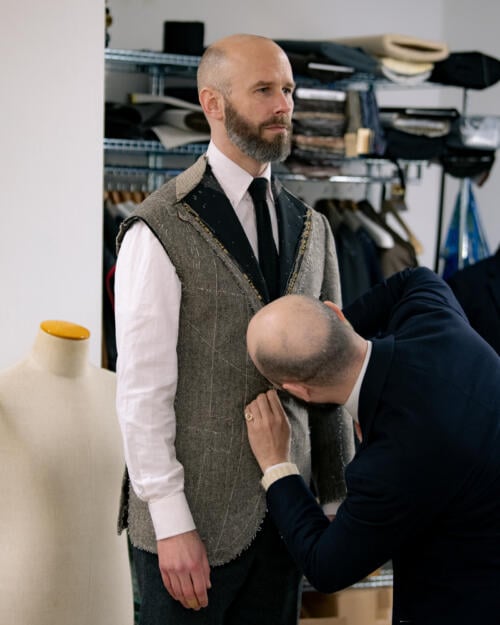
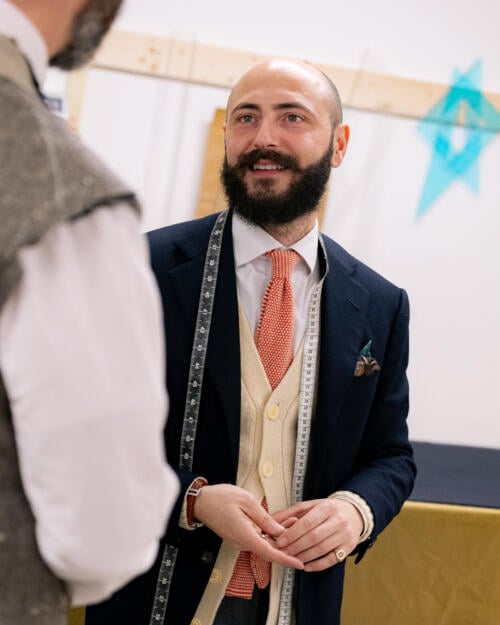
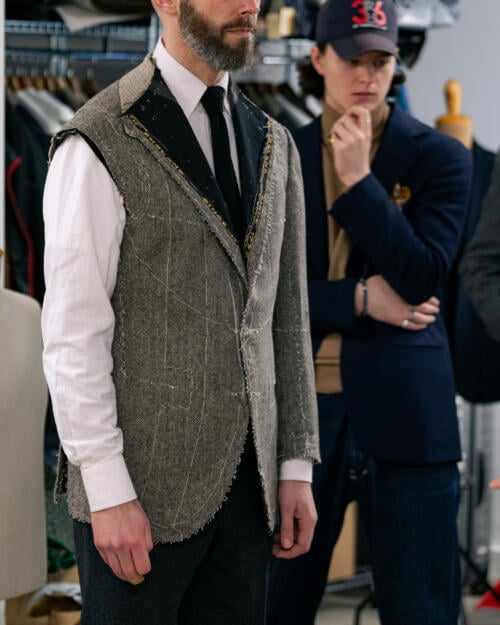
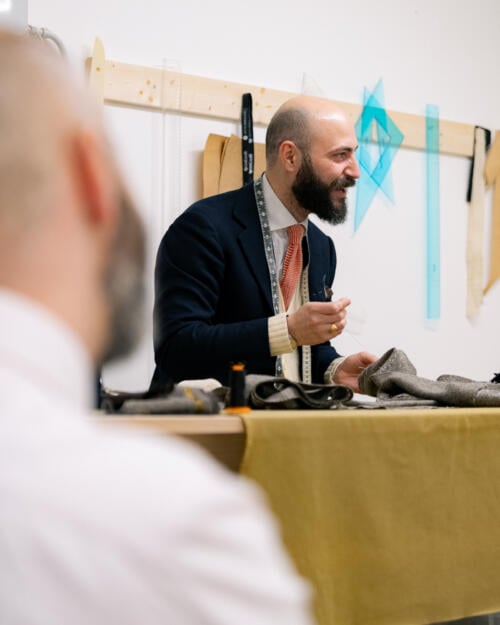
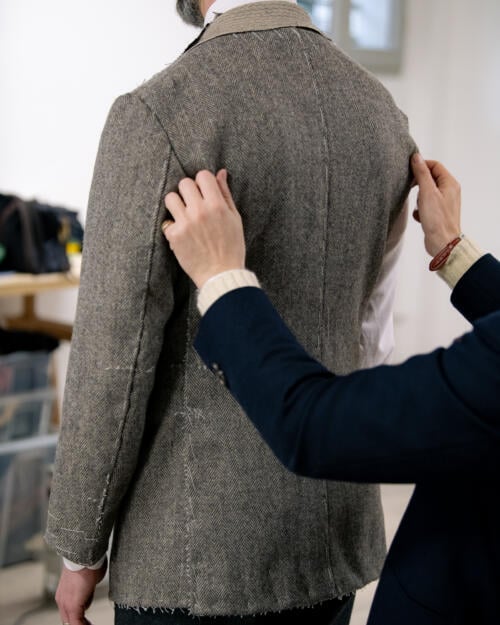
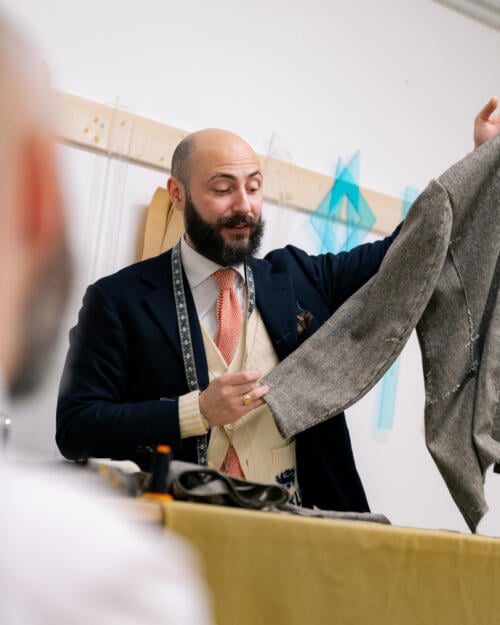
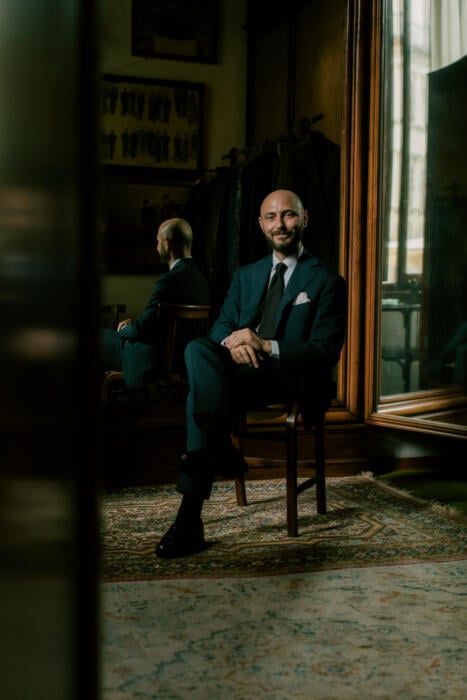

























Great new talent.
Fox tweed is got to be a great choice.
Can you see any similarity to Sartoria Corcos. Maybe too early to make a comparison.
With the sad closure of F. Caraceni,it’s greet to see rising talent and to keep this precious craft alive.
Health to enjoy and I’m looking forward to the review.
Thanks Lindsay.
Corcos is more his own style, and blends in some Neapolitan elements as we covered in the previous piece on him.
Despite the differences outlined here, most will find Salino more similar to Liverano on style
Many thanks
Simon, I have to ask…how many grey herringbone jackets is too many?
Ha! Maybe seven?
Take one down, pass it along… now six herringbone jackets are left!
Sing it, Simon, and raise your stein of flat, undrinkable British ale!
Only kidding.
And taken in good jest. I think we have to have a serious conversation about beer sometime though Leif. I might introduce you to a drink that tastes of something!
I know, as an American I shouldn’t be throwing stones when it comes to beer.
That flat Boddingtons stuff is actually tasty, as long as you don’t think of it as beer. And, not to try too hard to impress with my worldliness, but my favorite beer is Rothaus Tannen Zapfle Pils… but, this may be the stuff for some site called Permanent Drinking. Hmmm.
Yes, not one for here. Allow me just to say that Boddingtons is a load of rubbish
Hi,
Presumably, the new atelier mean that Vittorio is not continuing the collaboration with Sartoria Seminara?
Thanks,
SS
Yes that’s right, that didn’t work out unfortunately
It’s good to see Vittorio doing well, I remember him from his Liverano days. I love that Fox tweed fabric, Simon, I had been eying that one myself.
It is really lovely – only a subtle brown in the grey, and a cold shade too. Doesn’t look too rural, as a brown herringbone easily could
And it’s already sold out!
Blimey
Simon, did you ever come across a similar jacketing in a lighter weight? For me 500gms is to warm.
Thanks,
Manuel
Nothing off the top of my head, but put it on a list of things to look out for next time you’re browsing bunches
Don’t hide the imperfections, but rather show them elegantly! So Italian. Love it.
Quite a marketing slogan for the average consumer who is all too aware of his imperfections, though I’m certain he made this remark in a non-cynical way, it’s his heartfelt approach to things.
Lovely article and found myself nodding to each sentence in the final response.
My most recent bespoke commission was a single breasted in Fox Tweed TD9. Look forward to seeing how you style it.
Simon, are you aware of a change in EU tax regulations causing double taxation on cross-border transactions? My Italian tailor mentioned he now faces a requirement to pay VAT in both Italy and the receiving country when exporting a suit
No I’m not Lucas. I’d be surprised if that were the case. We certainly don’t with products we ship to the EU
Slightly unrelated question: do you know of any resources other than Google for finding trunk shows in a particular city? I might be moving to one of the cities Vittorio will visit and it will be the first time I’ll have such access.
The Valet is starting something like that. Not comprehensive yet but worth a look
Thank you, I’ll take a look.
Out of interest, Simon, how will this jacket differ from your grey herringbone from The Anthology style wise?
I think that’s probably better dealt with in he review piece, but at a basic level it will be similar – buttons, pockets, notch etc.
Thank you for this introduction to Salino. His answer to final question made me think a bit. While my current philosophy and use case largely mirrors what he described, I can’t help but feel like that a structured suit is much more likely to be the future of bespoke rather than an easy wearing unstructured sport coat. What I mean is that if a traditional bespoke exists in a 100 years time, its main attraction will still be the formal structured suit of some variation and that bespoke survived for that long or was revived along the way for said suit.
Well I’d argue the opposite will be the case. When there’s less need for a formal suit since the decline of dress codes (especially in work places) the opportunity to wear a jacket is more of a personal choice. Something you do because you just like to do so. And that’s where I see the usecase of Bespoke in the future, nice casual suitings. The tie seems to enjoy a renaissance in that way too at the moment-
In the workspace it would seem kinda silly to come in with ja Suit made from 160s Wool and a crisp twill-shirt in cotton with a tie if your boss just wears a dark jeans and a polo shirt.
We will see what the future brings, both – yours and mine – scenarios are likely to happen in my mind!
I don’t think structural means “formal”, look at Edward Sexton/Tom Ford/Husband Paris, plenty of casual structured jacket
Excellent ideas for american sized bodies. good interview.
Lovely article Simon! I think such pieces are a fantastic feature of this website and they remind me of the early days of PS. Also interesting to learn from the armoury interview that he was head cutter at liverano, that plus the price point make it a very interesting proposition!
I can see that Vittorio is wearing quite chunky knitwear under his tailoring, do you think his style is therefore on the roomier side?
Hey Nick,
Yes, as Vittorio mentioned in the article, he is a little roomier, slightly wider shoulders and a bigger chest, for comfort and ease as much as anything
Really enjoyed this. Very informative and gives an excellent insight to his approach, style and way of thinking. Also good to see talent such as Vittorio, who clearly has a passion for both the design side and the tailoring itself, strike out on his own.
Great interview.
Hi Simon, would you say the jackets in his house style will be casual enough to wear with chinos? How would you compare his cut vs Corcos on the formal – casual spectrum?
I think they would be, yes, and a similar level of casualness to Corcos, maybe a little more as it’s more relaxed in cut. Easier to talk about when we have the full piece on the finished jacket though
How do we contact him about the trunk shows?
Good question. I would try Instagram or email is [email protected]
Super nice guy, too.
Absolutely
Do you happen to know where the orange tie Mr. Salino is wearing is from? Is there any way to find out?
I don’t, but I can ask him
Hi Simon. I’m looking forward to seeing how this jacket turns out. I’ve been contemplating commissioning a grey sport coat for the cooler months. I was considering Fox TD8 (charcoal herringbone), or another Fox like this TD9, or instead opting for a grey herringbone cashmere like your old Ferdinando Caraceni jacket. Uses would be for a more casual office, as well as the occasional night out. I would likely pair the jacket with charcoal flannel trousers, but open to other options there as well. I was curious which jacket cloth you’d recommend given you have a few grey jackets now?
If it’s an office piece, and for nights out, I might lean towards the cashmere side of things
Thanks, Simon.
His approach to things is very appealing.
His prices are less than Liverano and many Neopolitan tailors. Good to see greed has not taken place in his tailoring shop. Look forward to the finished product and review.
Is there a reason why you always commission Grey Herringbone jackets?
Would it not be a good opportunity to commission pieces that add variety to your wardrobe rather than getting the same jacket?
Also, would you say its a better idea to commission lighter weight garments for your first experience with a new tailor, to see how well the fit really is?
I guess there’s always a balance there, Nick. Bear in mind I already have a lot of jackets and suits, so there’s really not that much need for variety. Then, I always want to commission something that I think will suit the style of the tailor, and present them in the best light. That’s usually the top priority. And I also like commissioning things I know I’m going to wear a lot, and I know I will with this, particularly given the brown/grey shade.
I wouldn’t say that on a first commission, no. If anything, given the second jacket will always fit a tiny bit better than the first, I’d go with something easier to fit. But in any case, I’d prioritise something I know I’d wear a lot.
Thank you for the reply, Simon.
Do you reckon the florentine cut (or perhaps just Vittorio Salino) works with jeans or chinos?
In the right fabric, yes it can do.
Could you expand on your comment regarding Vestrucci becoming mostly MTM? Do you have any insight into the strategy/positioning of the tailoring in Stefano Bemer now that Loris has retired?
I just know they are doing less bespoke than they were, and the emphasis has been more on MTM.